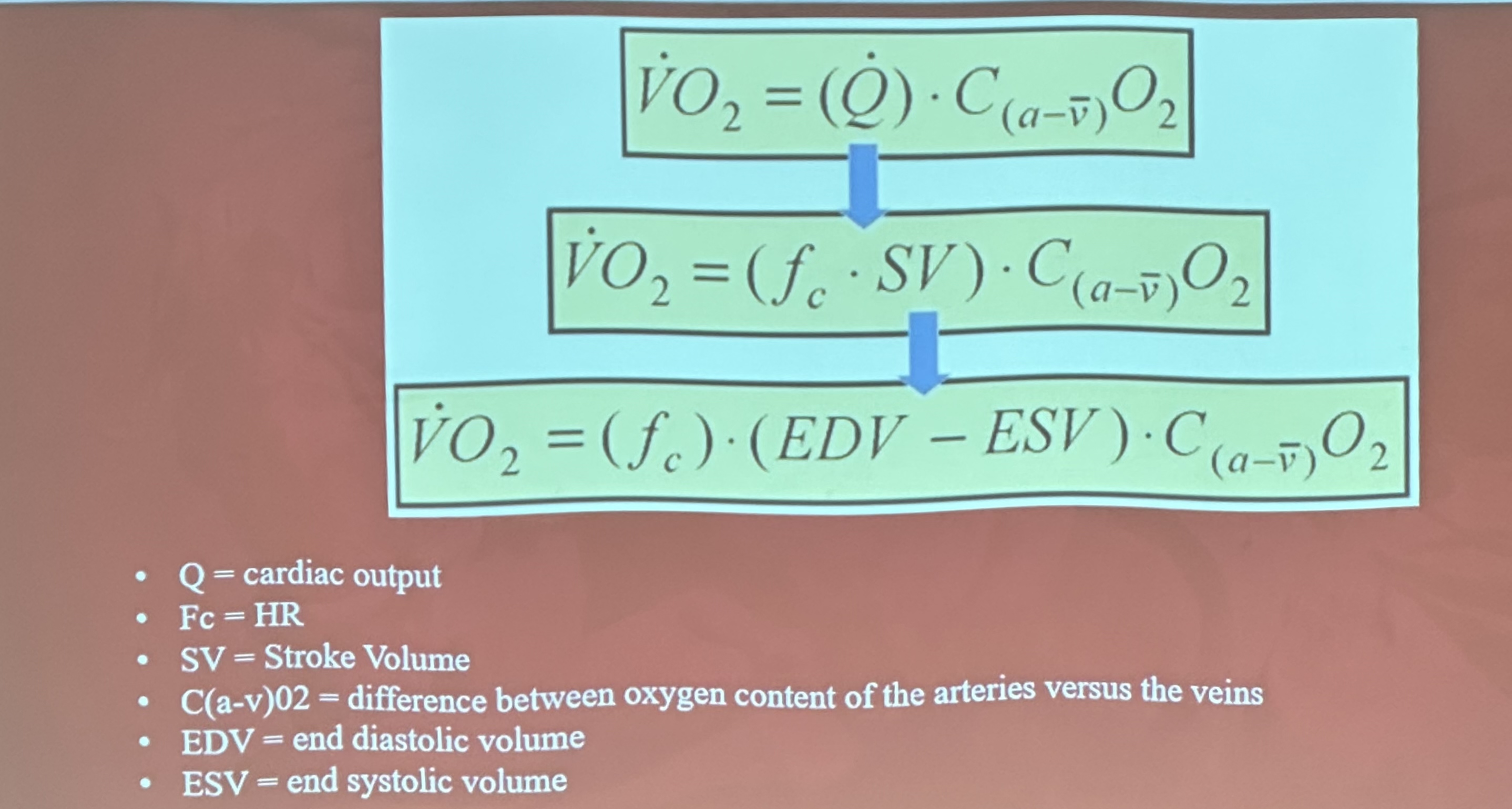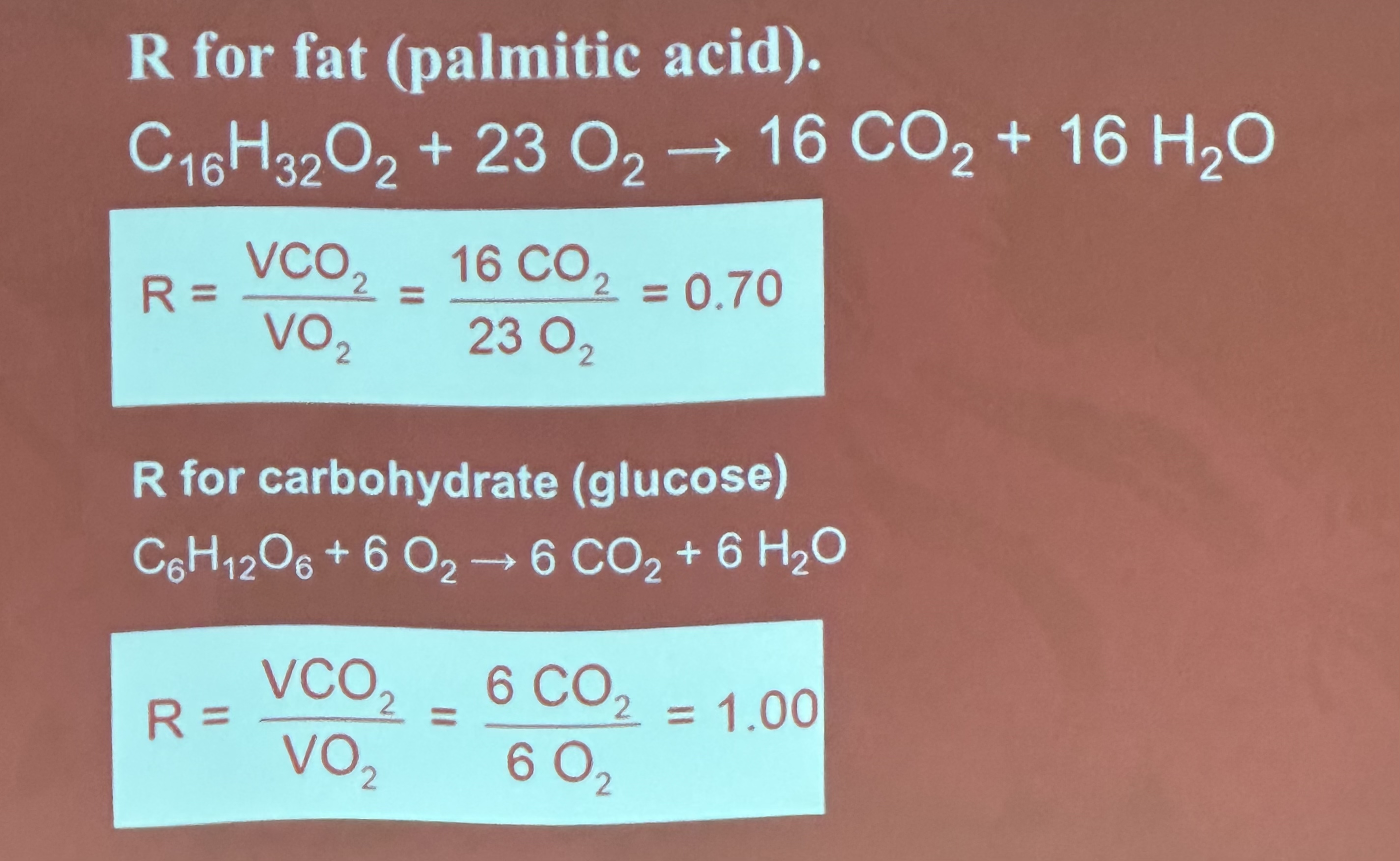Bioenergetics Pt 3
Fick Equation
VO2 = (Q) x C(A-V)(O2)
VO2 = (Fc x SV) x C(a-v)O2
VO2 = (Fc) x (EDV-ESV) x C(a-v)O2
Q = cardiac output
Fc = HR
SV = stroke volume
C(a-v)O2 = difference between oxygen content of the artiers versus the veins
EDV = end diatolic volume
ESV = end systolic volume

Limits to VO2
The biggest one we know about is the ability to deliver to the oxygen to the muscles
increase HR
increase diamter to muscles
The biggest adpatation to imporvijng VO2 is increasing cardiac output
Otherways we can deliver more oxygen to cells
More red blood cells
more blood volume
more cappilaries in the muscles
greater ventilartion rates and greater perfusion ox oxygen lungs
More myglobin
more mitochondria
Cardiac Output = HR x SV
Estimation of fuel utilizing during submaximal exercise
 Exercise Intensity and fuel selection
Exercise Intensity and fuel selection
Fats serve as a primary fuel source for muscles during low-intensity exercise 30% max,
Carbohydrates dominate at high intensity 70%
This shift in fuel selection, as exercise intensity rises, carbohydrate metabolism increases and fat metabolism decreases,
reaching a point known as the crossover point
Two main factors explain this shift:
Recruitment of fast muscle fibers
Rising blood levels of epinephrine
Fast fibers, which are recruited as intensity increases, are better suited for carbohydrate metabolism due to their abundance of glycolytic enzymes and lack of fat breakdown enzymes
Elevated epinephrine levels enhance glycogen breakdown, increasing glycolysis and lactate production
Lactate further inhibits fat metabolism, leading muscles to rely more heavily on carbohydrates as the primary fuel.
Exercise Duration and Fuel Selection
During prolonged (over 30 minutes), moderate-intensity (40%–60% max) exercise, the respiratory quotient (R) decreases over time, signaling a shift from carbohydrate to fat metabolism
Fat metabolism is influenced by factors controlling lipolysis
the breakdown of triglycerides into free fatty acids (FFAs) and glycerol, facilitated by lipases activated by hormones like epinephrine, norepinephrine, and glucagon
During low-intensity exercise, increased epinephrine levels enhance lipase activity, promoting lipolysis and elevating FFA levels in the blood and muscles
Lipolysis is typically slow, with significant fat metabolism occurring only after 10 to 20 minutes of exercise
Insulin and high lactate levels inhibit FFA mobilization, with rising insulin from a carbohydrate-rich intake before exercise potentially reducing lipolysis and increasing carbohydrate utilization.
Fats/Carbohydrates
During short-term exercise, glycogen and blood glucose levels typically remain sufficient
During prolonged exercise (over 2 hours), glycogen stores in muscles and the liver can deplete, leading to muscular fatigue
Low muscle glycogen levels reduce glycolysis and, consequently, the concentration of pyruvate, which is crucial for the Krebs cycle to produce ATP efficiently
Adequate glycogen levels allow for a significant increase in Krebs-cycle intermediates, necessary for high ATP demands during exercise
When glycogen is depleted, pyruvate levels drop, resulting in fewer Krebs-cycle intermediates, which slows ATP production
This impairment in ATP generation also affects fat metabolism since fats are oxidized through the Krebs cycle, demonstrating that carbohydrates are essential for optimal energy production
Sources of Carbs during exercise
Carbohydrates are stored as glycogen in the muscles and liver
Muscle glycogen provides energy directly for muscle metabolism, while liver glycogen helps maintain blood glucose levels
During prolonged exercise, if blood glucose drops, the liver releases glucose into the bloodstream, which is then used by the muscles
The contribution of muscle glycogen and blood glucose to energy metabolism varies with exercise intensity
blood glucose is more important during low-intensity exercise
muscle glycogen is the primary source during high-intensity efforts. Initially, during submaximal exercise (65%–75% max)
most of the carbohydrate used comes from muscle glycogen, but as these stores deplete, blood glucose becomes more significant.
Sources of Fat during exercise
When an individual consumes more energy than they expend, the excess is stored as fat, with 3500 kcal resulting in 1 lb of fat
Most fat is stored as triglycerides in white adipocytes, though some is also found in muscle cells
For triglycerides to be used for energy, they must be broken down into free fatty acids (FFA) and glycerol
FFA can then be converted into acetyl-CoA to enter the Krebs cycle
The use of fat as fuel varies with exercise intensity and duration
During prolonged low-intensity exercise, plasma FFAs from adipocytes are the main fuel source, while muscle triglycerides are used more at higher intensities
At moderate exercise intensities (65%-85% max), both plasma FFA and muscle triglycerides contribute equally, but as exercise continues, plasma FFA's contribution increases.